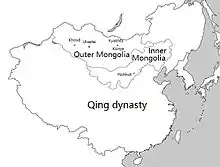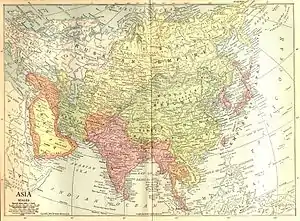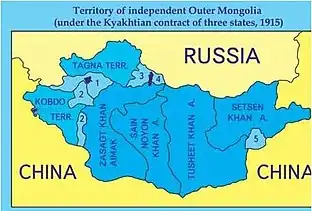Outer Mongolia
Northern Mongolia (Mongolian script: ᠭᠠᠳᠠᠭᠠᠳᠤ
ᠮᠣᠩᠭ᠋ᠣᠯ or ᠠᠷᠤ
ᠮᠣᠩᠭ᠋ᠣᠯ , Mongolian Cyrillic: Гадаад Монгол or Ар Монгол, romanization: Gadaad Mongol or Alr Mongol; Manchu: ᡨᡠᠯᡝᡵᡤᡳ
ᠮᠣᠩᡤᠣ Tülergi Monggo; Chinese: 外蒙古; pinyin: Wài Měnggǔ)[1] was a territory of the Qing dynasty (1691–1911). Its area was roughly equivalent to that of the modern state of Mongolia, sometimes called "Northern Mongolia" in China today, plus the Russian republic of Tuva.




While the administrative Northern Mongolia only consisted of the four Khalkha aimags (Setsen Khan Aimag, Tüsheet Khan Aimag, Sain Noyon Khan Aimag, and Zasagt Khan Aimag), in the late Qing period "Northern Mongolia" was also used to refer to Khalkha plus Oirat areas Khovd and the directly-ruled Tannu Uriankhai (Chinese: 唐努乌梁海).
Names
The name "Northern Mongolia" is contrasted with South Mongolia,[1] which corresponds to the region of Southern Mongolia in China. South Mongolia was given its name because it was more directly administered by the Qing court; North Mongolia (which is further from the capital Beijing) had a greater degree of autonomy within the Qing empire.[2]
There are three alternate terms including Ar Mongol, Mobei Mongol, and Northern Mongolia.
Ar Mongol
The term ar mongol or Mobei Mongol (Chinese: 漠北蒙古; pinyin: Mòběi Měnggǔ; lit. 'North of the Desert Mongolia') is sometimes used in Mongolian (or Chinese) language to refer to North Mongolia[3] when making a distinction with South Mongolia, so as to elide the history of Qing rule and rather imply a geographic unity or distinction of regions inhabited by Mongols in the Mongolian Plateau.[4] There also exists an English term Northern Mongolia.[4]
Ar Mongol can also be used to refer to Mongolia synchronically, during that time period.[5] In the Mongolian language, the word ar refers to the back side of something, which has been extended to mean the northern side of any spatial entity, e.g. a mountain or a yurt. The word öbür refers to the south (and thus protected) side of a mountain.[6] So the difference between South Mongolia and the Mongolian state is conceived as the metaphor of the backward northern side and the south side of a mountain.
In contrast to Mobei Mongol (Chinese: 漠北蒙古), there is also Monan Mongol (Chinese: 漠南蒙古; pinyin: Mònán Měnggǔ; lit. 'South of the Desert Mongolia'), roughly referring to the region now known as South Mongolia.
Modern usage
Today, "Northern Mongolia" is sometimes still informally used to refer to Mongolia. "Northern Mongolia" is also used quite commonly in Taiwan. To avoid confusion between the nation of Mongolia and China's Inner Mongolia, media in China generally refer to the former as "State of Mongolia" (Chinese: 蒙古国; pinyin: Ménggǔ Guó); that is, the translation of the official name in Mongolian, Монгол Улс/Mongol Uls, instead of just "Mongolia" (Chinese: 蒙古; pinyin: Ménggǔ), which could refer to the whole Mongolia area.
See also
Notes
References
- Huhbator Borjigin. 2004. The history and political character of the name of 'Nei Menggu' (South Mongolia). Inner Asia 6: 61-80.
- The Cambridge History of China, volume 10, p 49.
- cf. Norcin, C. (1999): Monggol kelen-ü toli. Ömnud monggol-un arad-un keblel-ün qoriya. Page 170.
- Bulag, Uradyn (1998). Nationalism and Hybridity in Mongolia. Clarendon Press. pp. 179–180.
- Bawden, Charles (1997): Mongolian-English dictionary. London: Kegan Paul. Page 23.
- cf. Norcin, C. (1999): Monggol kelen-ü toli. Ömnud monggol-un arad-un keblel-ün qoriya. Page 169, 580. ömnud: agula dabagan-u engger tal-a-yin gajar.